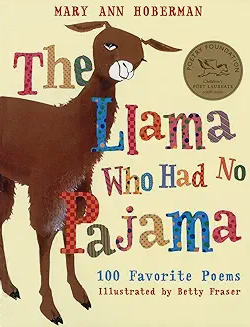Book Review: The Llama who had no Pajamas
1.
BIBLIOGRAPHY
Hoberman, M. A., & Fraser, B. (2006). The Llama who had no pajama: 100 favorite poems. Harcourt Brace & Co. ISBM: 0152055711
2. PLOT SUMMARY
This cute book is a poetry collection with one hundred different poems for young children. These poems center around different activities and animals that children can relate to daily. This entire collection of short poems engages young readers through repetitions, tongue twisters, and rhymes.
3.
CRITICAL
ANALYSIS
After reading the different poems in this book, I thought some poems were silly but cute. Each poem is unique written, catchy, and plays with words. Hoberman uses a lot of different types of figurative language like repetition, alliteration, and sensory language to engage young readers. As I read through Rabbit, I was quickly reminded Mother’s Goose’s Itsy-Bitsy Spider. As I read through some of the poems, I found myself singing some of the verses. One of my favorite poems in this collection was Yellow Butter. It took me back to my childhood and reminds my of my daily struggles as my children enjoy their peanut butter and jelly sandwiches.
Fraser’s illustrations are colorful and fun, which makes it easy to capture the attention of readers of all ages. Some of the illustrations are extremely realistic, like Mayfly and Jump Rope, while others perfectly depict the words from the poems. Fraser’s attention to detail adds great value to each poem.
*This is a great resource to introduce students to figurative language.
4.REVIEW EXCERPT(S)
Children’s
Poet Laureate
Starred review in Horns Books “This collection of some
forty years of Hoberman verse is a charmer."
Starred review in School Library Journal: “Good for beginning or experienced readers of poetry.”
5.
CONNECTIONS
* Use an
anchor chart to introduce students to different forms of Figurative Language.
Then, as you read the poems aloud, have students identify different examples of
figurative language.
*
Engage young readers in a poetry writing session using different forms of
figurative language. Have students come up with their own poem.
*
Use this book to introduce young readers to rhyming words, engage readers into
coming up with their own rhyming words.
*
Books that inspire poetry writing:
Alexander, K. (2023). How to write a poem. Quill Tree Books.
ISBN: 0063060906
Massachusetts
St. Mary’s Catholic School. (2005). Haiku hike. Scholastic.
ISBN:
043982253X
Review completed for SHSU MLA course



Comments
Post a Comment